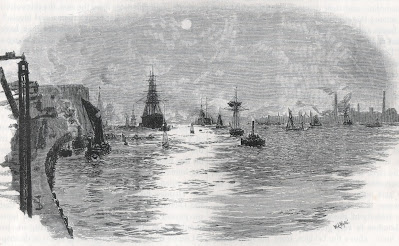Now I am back with my copy of Bradshaw’s Illustrated Hand Book to London and Its Environs, which was published in 1861.
Mr. Bradshaw will be familiar to many as the man who produced the series of railway timetables and guides which have accompanied Michael Portillo in his delightful Great Railway Journeys.
But he was more than this, and was also a prodigious cartographer and publisher, whose work included an excellent guide to our canal network.
Sadly, while touring Norway in 1853 he contracted cholera and died in September of that year without returning to England.
All of which means that technically Bradshaw’s Illustrated Hand Book to London and Its Environs was not Mr. Bradshaw’s, but no matter.
Had I bought my copy in 1861 I might have been intrigued at the promise of Woolwich which from the River offered “long lines of walls, closely pressed tide gates, with the bows of many a noble vessel towering proudly over them from their docks, like sea monsters on their thrones, looking down in scorn on the river waves; the high heaps of timber , with the huge coiled cables, the church tower in the background, the heavy lighters crowded along the shore, and the light racking craft with pennants streaming in the wind …….”
And having waxed lyrical and at much length about the view from the Thames, the guide goes on to reference, The Rotunda, Cannon Foundry, Arsenal and Barracks, before concluding with “the bankside tavern , halfway between London and Gravesend is a conspicuous object on the Kent coast”.
I have yet to work out which tavern this was, and a second and more extensive entry a few pages on is equally silent as to the name of the place.
That said the second entry deals in more detail with The Rotunda, Cannon Foundry, Arsenal and Barracks, and is well worth a read.
But having started out with such praise for our Woolwich the guide slides away from compliments, concluding “Though within a short period nearly 2,000 additional houses have been built, the town presents few inducements for a prolonged visit, and has no feature of interest in itself what ever.
The old church looks better at a distance and there are few monuments in the churchyard bearing names familiar to the eye and ear”.
And so, having started by describing how Woolwich can be reached by water or by road via Charlton and Shooter’s Hill, it closes with offering “four speedy modes of transit back to town”, which involve various different steamers and trains, leaving the excursionist to consult his own convience for preference of choice”.
Adding that a series of facts which all travellers would want to know, starting with “the Woolwich station, eight miles and twenty-one chains from London is in the close vicinity of the Barracks; the two tunnels between Woolwich and Charlton are respectively, 120 and 100 yards in extent; and the Blackheath tunnel near the Mordern College, is 1,681 yards long”.
Location; Woolwich
Pictures; The Thames and Woolwich Reach, 1885, Interior of the Rotunda, 1915, St Mary’s Parish Church, 1915, courtesy of Kristina Bedford, author of Woolwich Through Time, 2014
* Bradshaw’s Illustrated Hand Book to London and Its Environs, 1861



No comments:
Post a Comment